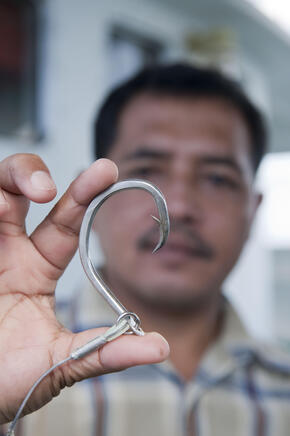Green Sea Turtle Oceanic Range Gis Downloadable Data UPDATED
Green Sea Turtle Oceanic Range Gis Downloadable Data
WWF works around the world to eliminate bounding main turtle bycatch from fisheries, reduce the unsustainable harvest and illegal trade in sea turtles, and stalk the loss of disquisitional sea turtle habitats. Many of these objectives are accomplished by establishing and strengthening protected areas effectually nesting beaches, raising awareness and promoting ecotourism, lobbying for turtle-friendly fishing practices, and more.
Eliminating Bycatch
WWF aims to reduce turtle bycatch by working with fisheries to switch to more turtle-friendly fishing hooks ("circle" hooks). Nosotros advocate for the employ of special turtle excluder devices in nets. WWF has worked with the National Oceanic and Atmospheric Administration (NOAA) to develop lights to reduce the bycatch of turtles in gill nets. These lights accept been shown to reduce turtle bycatch past threescore%-lxx%, and we are working to introduce them to fisheries around the globe. WWF also tracks turtle movements using satellites to help prevent future interactions between fisheries and turtles and work with fishermen to assist them salvage turtles caught in angling gear.

Addressing Overharvesting and Illegal Merchandise
WWF works with local communities to reduce turtle harvesting and egg collection. Because exploitation of turtles is often driven past a lack of economical choices, we help develop culling livelihoods so that local people are no longer dependent on turtle products for income. WWF likewise supports programs that promote the value of body of water turtles. WWF works through TRAFFIC, the wildlife trade monitoring network, to stop the illegal trade of turtle shells, meat, and eggs. We also railroad train and equip local rangers to patrol turtle nesting beaches and protect confronting poaching.
WWF has been supporting a campaign led past TRAFFIC to combat illegal merchandise from the Coral Triangle and reduce demand in China. Activities include ameliorate grooming for law enforcement officials in both areas and a public sensation campaign in Red china, targeting areas where turtle trade is the highest. Radio broadcasts and advocacy events spread the bulletin among local fishermen, gift shop owners, and tourists about the problem of turtle merchandise.
In the western Solomon Islands, WWF supports local rangers on the beaches throughout turtle nesting and hatching seasons to protect against egg harvesting and hunting. The rangers collect important data and inform their communities well-nigh laws to protect turtles.
Protecting Marine Turtle Habitat
WWF works around the globe to establish marine protected areas, ensuring sea turtles have a safe place to nest, feed, and migrate freely. We encourage governments to strengthen legislation on, and provide funding for, ocean turtle protection. WWF supports local turtle conservationists in many parts of the world to monitor and patrol turtle nests. These efforts oftentimes lead to ecotourism opportunities and offering alternative livelihoods.
Minimizing Climate Change Impacts
WWF studies how sea turtles are existence affected by climatic change and helps determine the best ways to reduce their vulnerability to irresolute environmental conditions. We work around the earth with communities to monitor and protect nesting beaches, helping turtles be more resilient to the future impacts of climatic change. In the Eastern Pacific and Caribbean, we work to raise sensation of the threat of sea level rising on nest sites and the importance of shade for nests.
Satellite Tracking
Satellite telemetry allows researchers to track bounding main turtles as they swim from place to place. These satellite tags do not harm the turtles in any manner and are designed to somewhen fall off. The data will tell us where important feeding areas are, aid us sympathize migration patterns and anticipate where turtles may come up in contact with fisheries and their gear. These projects include tracking of hawksbill turtles in Malaysia; leatherback turtles in Panama, Suriname, French Guiana, Uruguay, Republic of indonesia, and Gabonese republic; loggerhead turtles in Cape Verde; dark-green turtles in Cambodia; and olive ridley turtles in Australia.
DOWNLOAD HERE
Posted by: skaggsthrost.blogspot.com
